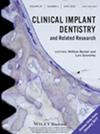Impact of Implant Mesiodistal Distance on Peri-Implant Bone Loss: A Cross-Sectional Retrospective Study
Abstract
Purpose
The purpose of this study was to verify the effect of our previously proposed mesiodistal distance for multiple posterior implants on preserving peri-implant bone, and to provide a measurable criterion for predicting implant prognosis.
Methods
One hundred and two patients with dental implants placed in the posterior free-end edentulous arches were recruited in this cross-sectional study. Calibrated X-rays (peri-apical [PA] or bite-wing x-ray) were collected to measure the mesiodistal space as well as the corresponding bone resorption of implants after prosthesis placement. Implants were assigned to the test/control group according to whether their mesiodistal distance following our proposed algorithm. After adjusting covariates, logistic multivariate regression analyses were performed to examine the relationship between inter-implant distance and marginal bone loss (MBL) during each follow-up interval. The effect of smoking habits was also analyzed.
Results
Every observation period exhibited great significance between experimental and control group on peri-implant bone level (p = 0.006, 0.005, 0.001, 0.025, 0.001, correspondingly) and the difference had a tendency to grow as time went by except 4-year (MD = −0.19, −0.39, −0.43, −0.30, −1.26, correspondingly). While no significant difference was observed between smokers and nonsmokers in the same group (p > 0.05).
Conclusion
The mesiodistal algorithm of 4–4.6 mm (implant to adjacent canine tooth), 7–7.4 mm, 8–8.5 mm, and 9–9.5 mm was proved to be effective for maintaining peri-implant bone level. It was also observed in our study that the impact of inter-implant distance outweighed that of smoking. This study provided clinicians predictable prognostic outcomes for implants and reference for deciding treatment plans.


 求助内容:
求助内容: 应助结果提醒方式:
应助结果提醒方式:


